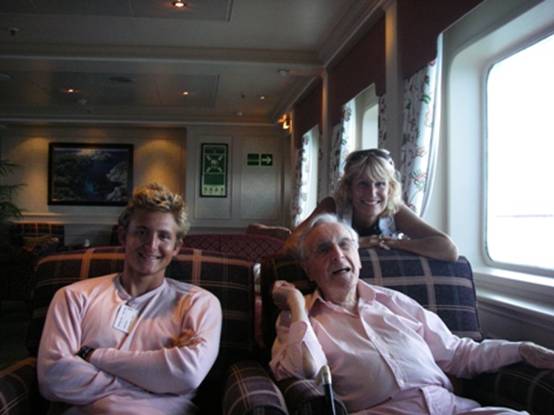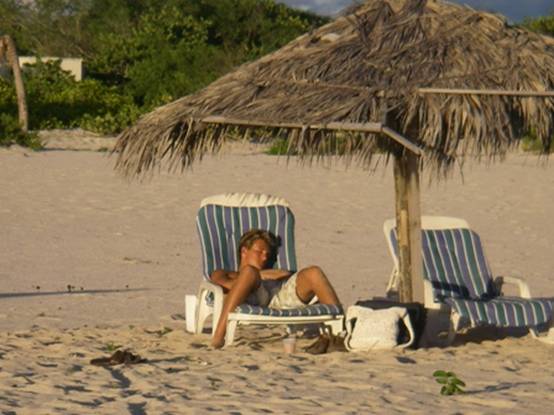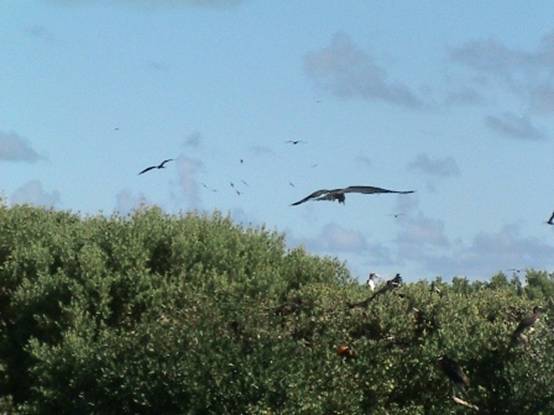BLUE WATER RALLY - BARBUDA EXPERIENCE

|
We had three very good reasons for visiting Barbuda – my Uncle
Michael, 88 years of age and extremely agile to boot, was coincidentally aboard
the luxury cruise ship Hebredian Spirit for Christmas and would be at anchor
off Low Bay for just one day – the 23rd December! The second
reason was of course to visit the largest colony of mating and nesting Frigate
birds in the world and the third was to see the pink beaches!
Pink shells on the sand! The Barbuda Express leaves
whereupon they sent a small tender to meet us at the dockside. We spent a wonderful and emotional three hours aboard with my Uncle and
his companions and (oh joy) the luxuries included comfy armchairs, fabulous
seafood cuisine on deck and flushing loos!!
With fond farewells to the five star luxuries we then set off to The
Palm Tree Hotel for the night so we could see the Frigates in the morning.
Well! talk about from the sublime to the ridiculous – all the
‘hotels’ are closed on Barbuda either for repair (?) or lack of
business and the ‘Palm Tree’ was little more than concrete bungalow
set in waste ground surrounded by a dubious metal fence! However, the beds
were made up with fresh laundry and despite a million mosquitoes champing at
our ankles we decided to make the best of what rapidly became obvious was our
only option! The island is very flat – hardly above sea level –
and extremely poor. Hundreds of donkeys and deer roam wild and we witnessed a
horse race of sorts over the hill. There is a reasonably stocked supermarket
in Codrington ‘Village’ and an almost deserted shack on the
‘pink’ beach where we spent the remainder of our day until sunset.
The blackboard clearly offers lobster or fish on the grill but further
investigation drew a negative (the owner laughingly told us this is just
written on as a joke – he has no food to offer and no way of cooking it
anyway!) The sand is actually a normal colour with swathes of Barbie doll
coloured pink shells washed up by the tides – very pretty. We had a ‘cook up’ that evening sitting at the plastic
table with dodgy legs, in the room cluttered with sofas, broken down TVs,
wobbly oscillating fans, baby’s push chairs, a neon lighting system and a
hundred and one family and friends all wandering in and out at random! The
‘girls’ were all busy cooking our dinner in the kitchen in the dark
(which I thought was the Barbudan way of keeping the bugs out of the food) but
it transpired the bulb had blown so we set of in a brand new Toyota Rav 4X4 to
find a replacement from a friend. It transpired that Serena, our host, loves It was a relief when Ray our Frigate guide turned up as pre arranged at
10.00am – we have been away from ‘home’ for three months and
it as gone like the wind (excuse the pun) but that was my longest night! A
beautiful sunny morning – we headed off towards the lagoon where we
parked the car, paid our Park Tax and Ray went off to get his wooden boat.
Quite a journey across the water of some fifteen minutes before we reached the
mangroves literally growing out of the sea where we knew the birds had their
colony. They have no natural predators and are fully protected. We spotted the
males’ red ‘balloons’ from a long way off and got terribly
excited but on closer inspection they turned out to be red mooring buoys! Okay, let me tell you what I now know about Frigate Birds! The mating
season starts in September at which time the males sit in the mangrove bushes
and with a little water and air manage to pump up their red necks into large
red balloons before getting themselves into an excited fervour – beating
their balloons with their beaks and thereby making a drumming sound to attract
a mate. There are incidentally many more males than females as during harsh hurricane
season the males have the strength to rise high above the clouds to remain safe
whilst the females and their young often perish. As you can imagine this has
had an adverse effect on the characters of the females who have become very
picky and full of their own self importance! They fly around on the thermals with
their huge wing spans and white chests until they spot a particularly
attractive red throbbing balloon at which point they fly down to investigate
further – the male gets even more excited and pumps himself up further
and drums away for all he is worth, at which point the female invariably cools
off and flies away! The bitch! Eventually though the lucky ones get picked for
the season and once coupled the red balloon shrivels up and the hard nesting
work begins!! The females sit tight until the males have gathered enough twigs
for her nest, and a lot of stealing of other birds’ twigs transpires,
whereupon just one egg is despatched into the family home. The male then
incubates the egg whilst the female flies out to sea to catch food (flying fish
and the like as they cannot dive below the surface of the sea). Once the chick
is born, the male’s duty is done and he flies away for a whole year to
another colony. The unlucky males cool down their balloons and join them!
Well, we visited the colony in December so as you can imagine the poor
remaining boys had been pumping solidly for three months and the girls who had
still not chosen their mate were playing a cruel game – swooping down
from the sky, hopping from one branch to another – giving hope and then
dashing it – it gives a whole new meaning to being lead on!!
The male is in the bush with the female swooping down from above!
The male is to the right, a white head denotes a chick. Back on the ferry (hoorah!) a bit of Christmas shopping in |





